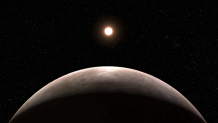There's a new heavy hitter in the hunt for planets beyond our solar system.
NASA’s James Webb Space Telescope — the next-generation observatory that has already beamed back some of the clearest and most stunning views of the universe — was used for the first time to confirm the existence of an exoplanet, scientists announced Wednesday.
The planet, called LHS 475 b, is a small and rocky world that is almost the same size as Earth, according to the research team, led by astronomers at the Johns Hopkins University Applied Physics Laboratory in Laurel, Maryland. The research was presented Wednesday at the 241st meeting of the American Astronomical Society in Seattle.

Get New England news, weather forecasts and entertainment stories to your inbox. Sign up for NECN newsletters.
The exoplanet confirmation marks an important milestone for the $10 billion Webb telescope, which launched into space in December 2021 and began science operations less than a year ago. The finding demonstrates how the observatory could be used to search for potentially habitable planets in the cosmos and examine the chemical makeup of their atmospheres.
Read the full story on NBCNews.com here.

